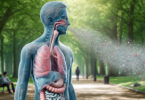Guest Writer for Wake Up World
It’s been a couple years since the Fukushima disaster but the ruins are still smoldering and the negative health consequences are more pronounced than ever. The somewhat indifferent response from many governmental health agencies around the world to the Fukushima disaster was perhaps more shocking than the disaster itself. Authorities around the globe assured us not to worry, claiming any radiation that had come into contact with citizens was well below the detectable and harmful level. The message is clear, everyday citizens can longer rely on their government for protection.
As tons of radioactive water continues to spill into the Pacific Ocean, many national health agencies have raised the standards for acceptable radiation exposure to reinforce their absurd statements. The previous standards for 30 years of radiation exposure would have generated a cancer rate of 1 in 10,000. Now that radiation standards have been raised (thanks to the Obama Administration’s green-lit effort to increase radiation exposure to 2,000 millirems), the cancer rate from 30 years of exposure is now at 1 in 23! [1]
What other problems have sprung up since the nuclear disaster in Fukushima?
1. Skin Contamination
Skin contamination remains one of the greatest risks following a radiological disaster like Fukushima. The availability of radiological decontamination agents remained in limited supply immediately following the disaster, and many of these agents require fresh water. Unfortunately, access to clean water can be very difficult in areas near Fukushima due to the high levels of radiation.[2] Skin exposure to chemicals and radiation may result in superficial skin issues and endocrine damage. [3]
2. Psychological Trauma
Data indicates that workers and mothers of young children have the greatest risk of PTSD, depression, and anxiety following a radiological event. These effects may be a direct result from exposure to radiation, and radiation itself may be directly linked to mood disorders. Also, parents may fear for their family’s well being during and after a nuclear disaster, further increasing the chances of becoming psychologically and emotionally unstable.[4] Children and adolescents may also experience long-term psychological difficulties with unknown consequences. [5]
3. Cancer
Scientists and governmental health agencies have been highly aware of radiation’s impact on cancer risk in humans and animals. High doses can be fatal and increase the chances of inheritable genetic defects.[6]
4. Thyroid Damage
Iodine 131, a radioisotope of iodine found in nuclear fission, quickly accumulates in the thyroid and replaces stable, beneficial iodine. It disrupts normal thyroid function to negatively impact hormones, body weight, and energy levels. This iodine isotope can cause thyroid cancer and hypothyroidism. [7] Nuclear disasters, specifically those in Chernobyl, Hiroshima, and Fukushima, have resulted in a significant increase in thyroid cancers.[8]
5. Women are More at Risk
Research conducted in the area around Fukushima explored the impact radiation had on men and women and how the genders compared when it came to health risk severity. Women proved more sensitive to the effects of radiation, with pregnant women displaying an even higher level of susceptibility. [9]
6. Pregnancy Issues
Pregnant women are at a higher risk for developing issues related to iodine deficiency when exposed to iodine 131, an issue that can slow thyroid and hormone function. Iodine deficiency in pregnant women can cause miscarriage, stillbirths, and other complications.[10] As the years continue to pass following the Fukushima disaster, Japanese officials still claim ignorance of the possible effects radiation has on pregnant women and their unborn children.
7. Thyroid Disorders and Newborns
Despite the multitude of health effects to the developing fetus, research has uncovered severe issues with radiation on the thyroid gland in newborn infants. From March to June of 2011, thyroid problems soared 28% in babies born along the Pacific Rim. States along this area include Hawaii, California, Oregon, Washington, and Alaska. A 2013 study published in Open Journal of Pediatrics noted significantly higher incidences of hypothyroidism in these states. [11]
8. Thyroid Cancer in Children
During a radiological event, protecting the health of children (the most susceptible population group) becomes a foremost issue. [12] To date, 44 Japanese children under the age of 18 living near Fukushima’s nuclear plant at the time of the disaster have developed thyroid cancer, a significant increase compared to cancer incidences prior to the event.
What Can Be Done During a Nuclear Event?
Any type of nuclear emergency requires immediate action in an effort to protect citizens. Government authorities will typically administer high doses of potassium iodide to those affected in an effort to block thyroid absorption of iodine 131. [13] While this traditional protocol may help, the results show the need for better, more effective protective options.
When it comes to protecting yourself and your family, you ultimately have to rely on your own efforts rather than those exercised from official members of the government. Although potassium iodide has been traditionally used to block the absorption of iodine 131 in the thyroid, it is not the most efficient form of iodine for the human body. Nascent iodine offers a more bioavailable option with a higher rate of absorption. Detoxification may also be helpful for removing impurities and toxic metals that may accumulate during a nuclear event.
What are your favorite ways to protect yourself from overseas radiation? Let us know in the comments!
-Dr. Edward F. Group III, DC, ND, DACBN, DCBCN, DABFM
Article References:
- Global Research News. Civilian Cancer Deaths Expected to Skyrocket Following Radiological Incidents.Public Employees for Environmental Responsibility (PEER).
- Tazrart A, Bérard P, Leiterer A, Ménétrier F. Decontamination of radionuclides from skin: an overview. Health Phys. 2013 Aug;105(2):201-7. doi: 10.1097/HP.0b013e318290c5a9.
- Asfandyar Khan Niazi and Shaharyar Khan Niazi. Endocrine effects of Fukushima: Radiation-induced endocrinopathy. Indian Journal of Endocrinology and Metabolism. 2011 April-June; 15(2): 91-95.
- Bromet EJ. Emotional consequences of nuclear power plant disasters. Health Phys. 2014 Feb;106(2):206-10. doi: 10.1097/HP.0000000000000012.
- Hayashi K, Tomita N. Lessons learned from the Great East Japan Earthquake: impact on child and adolescent health. Asia Pac J Public Health. 2012 Jul;24(4):681-8. doi: 10.1177/1010539512453255.
- Boice JD Jr. Radiation epidemiology: a perspective on Fukushima. J Radiol Prot. 2012 Mar;32(1):N33-40. doi: 10.1088/0952-4746/32/1/N33.
- Spallek L, Krille L, Reiners C, Schneider R, Yamashita S, Zeeb H. Adverse effects of iodine thyroid blocking: a systematic review. Radiat Prot Dosimetry. 2012 Jul;150(3):267-77. doi: 10.1093/rpd/ncr400.
- Dilas LT, Bajkin I, Icin T, Paro JN, Zavisi BK. Iodine and thyroid gland with or without nuclear catastrophe. Med Pregl. 2012 Nov-Dec;65(11-12):489-95.
- Evangeliou N1, Balkanski Y2, Cozic A2, Mà¸ller AP3. Global and local cancer risks after the Fukushima Nuclear Power Plant accident as seen from Chernobyl: A modeling study for radiocaesium (134Cs &137Cs). Environ Int. 2013 Dec 19;64C:17-27. doi: 10.1016/j.envint.2013.11.020.
- http://www.ncbi.nlm.nih.gov/pubmed/22742605
- Joseph J. Mangano, Janette D. Sherman. Elevated airborne beta levels in Pacific/West Coast US States and trends in hypothyroidism among newborns after the Fukushima nuclear meltdown. Open Journal of Pediatrics, 2013, 3, 1-9 OJPed.
- Fushiki S. Radiation hazards in children – lessons from Chernobyl, Three Mile Island and Fukushima. Brain Dev. 2013 Mar;35(3):220-7. doi: 10.1016/j.braindev.2012.09.004.
- Reiners C, Schneider R. Potassium iodide (KI) to block the thyroid from exposure to I-131: current questions and answers to be discussed. Radiat Environ Biophys. 2013 May;52(2):189-93. doi: 10.1007/s00411-013-0462-0.
Article References:
1. Dr Philippe Grandjean MD, Philip J Landrigan MD. Neurobehavioural effects of developmental toxicity. The Lancet Neurology, Volume 13, Issue 3, Pages 330 – 338, March 2014. doi:10.1016/S1474-4422(13)70278-3.
Previous articles by Dr. Group:
- The Benefits of Organic Soap
- Ten Shocking Facts about Mercury Amalgam
- 10 Shocking Facts about the Health Dangers of Wi-Fi
- The 9 Best Herbs for Lung Cleansing and Respiratory Support
- 7 Best Foods to Support Kidney Function
- How to Flush the Liver
- Lung Cleansing With Peppermint Oil
- The Benefits of Organic Hemp Milk + How to Make Your Own
- What is Azodicarbonamide? 9 Facts About This Dangerous Food Additive
- 8 Must-Know Facts About Fukushima Nuclear Radiation
- Nine Shocking Dangers of Fluoride Exposure
- 10 Natural Remedies for Kidney Stones
- 12 Shocking Facts About the Dangers of Psychiatric Drugs
- Seven Facts You May Not Know About Coconut Oil
About the author:
 Dr. Edward F. Group (DC, ND, DACBN, DCBCN, DABFM) founded Global Healing Center in 1998 and is currently the Chief Executive Officer. Heading up the research and development team, Dr. Group assumes a hands-on approach in producing new and advanced degenerative disease products and information.
Dr. Edward F. Group (DC, ND, DACBN, DCBCN, DABFM) founded Global Healing Center in 1998 and is currently the Chief Executive Officer. Heading up the research and development team, Dr. Group assumes a hands-on approach in producing new and advanced degenerative disease products and information.
Dr. Group has studied natural healing methods for over 20 years and now teaches individuals and practitioners all around the world. He no longer sees patients but solely concentrates on spreading the word of health and wellness to the global community. Under his leadership, Global Healing Center, Inc. has earned recognition as one of the largest alternative, natural and organic health resources on the internet.

If you've found value in our articles, we invite you to support the release of our brand-new book, "Gratitude Practices for Kids: A Practical Guide for Adults to Instill a Spirit of Appreciation and Positivity in the Next Generation."
"Gratitude Practices for Kids" brings together over 25 innovative and accessible practices designed to enhance gratitude in everyday life. This comprehensive guide is backed by 17 scientific studies, ensuring each concept is grounded in research, underscoring our commitment to nurturing growth, emotional intelligence, and positive interactions between adults and children.
We encourage you to opt for the paperback version to celebrate this new release. Dive into its fresh pages away from digital distractions, allowing you to immerse yourself in the transformative practices it offers.
Over recent years, Wake Up World has faced significant online censorship, which has impacted our financial ability to operate. Moving into book publishing represents a strategic step to secure the ongoing funds needed to continue our mission. By purchasing Gratitude for Kids, you help us keep our content free and accessible to everyone, avoiding needing a paywall. With over 8,500 articles published in the last 13 years, we remain dedicated to keeping our valuable content open to all.








